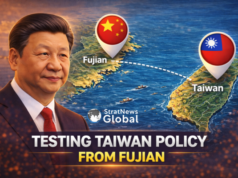At the recently concluded BIMSTEC summit in Bangkok, regional cooperation appeared to gain traction, even as old hurdles remained.
In this edition of The Gist, Dr. Constantino Xavier, senior fellow in foreign policy and security studies at the Centre for Social and Economic Progress, reflects on both the promise and pitfalls of the multilateral gathering.
“Like many regional summits, BIMSTEC is as much about bilateral exchanges in the margins as it is about formal multilateral outcomes,” he said. Despite this, Dr Xavier noted a growing political momentum, with leaders meeting more regularly to shape a collective vision for the Bay of Bengal region.
One of the key takeaways from the summit was Prime Minister Modi’s announcement of a BIMSTEC Home Ministers’ mechanism, focused on cross-border security issues such as trafficking and insurgency. “This reflects a growing comfort among member states to discuss sensitive security challenges together,” he said.
However, the economic front showed little progress. Talks on a free trade agreement—stalled since 2004—remained stagnant. “It’s a clear signal that the broader regional trade agenda is struggling,” Xavier observed.
Interestingly, power dynamics within the bloc appear to be shifting. While smaller nations have historically viewed India’s influence with caution, Xavier suggests a reversal. “Except for Bangladesh, most member states now see India as an anchor for economic and strategic stability—and want more, not less, Indian leadership,” he said.
Still, irritants persist. Non-tariff barriers and red tape hamper regional trade. “We’re still stuck in outdated bureaucratic systems where, absurdly, each sock is counted as a separate item,” he pointed out. Despite these quirks, India has made strides in trade facilitation and connectivity.
As for tangible outcomes, Xavier highlighted three: greater energy cooperation, deeper regional security dialogue, and a growing push for infrastructure connectivity. While critics question BIMSTEC’s pace, Xavier stressed that summits are just the visible tip of ongoing work. “The real action happens between the summits—in the quiet but crucial sectoral meetings.”
In a region grappling with economic transitions and strategic flux, BIMSTEC may not be moving fast—but it is moving. Watch the full interview here to get some fascinating insights into why BIMSTEC matters.
In a career spanning three decades and counting, Ramananda (Ram to his friends) has been the foreign editor of The Telegraph, Outlook Magazine and the New Indian Express. He helped set up rediff.com’s editorial operations in San Jose and New York, helmed sify.com, and was the founder editor of India.com.
His work has featured in national and international publications like the Al Jazeera Centre for Studies, Global Times and Ashahi Shimbun. But his one constant over all these years, he says, has been the attempt to understand rising India’s place in the world.
He can rustle up a mean salad, his oil-less pepper chicken is to die for, and all it takes is some beer and rhythm and blues to rock his soul.
Talk to him about foreign and strategic affairs, media, South Asia, China, and of course India.




